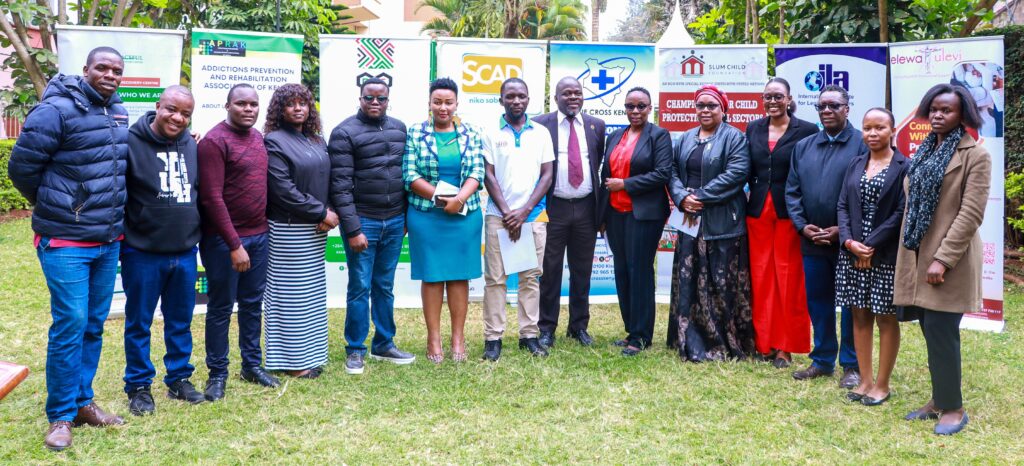By Victoria Musimbi
In households across Kenya, alcohol abuse is leaving a trail of broken families, lost livelihoods, and shattered futures. Children are going to bed hungry as family income is drained into alcohol purchases. Women are enduring violence at the hands of intoxicated partners or relatives. Many breadwinners have lost jobs, while others lie in hospital beds or rehabilitation centres, victims of alcohol-fuelled injuries or addiction.
In response to this crisis, civil society, children rights advocates and health professionals are rallying to defend and push for the swift Implementation of the new National Alcohol and Drugs Policy 2025.
“Alcohol is not just a personal choice it’s a public health crisis that is robbing our children of education, safety, and a stable home life,” says Susan Gitau, CEO of the Alcohol and Drug Prevention and Rehabilitation Association of Kenya (APRAK) and founder of Elewa Ulevi. “We have seen children drop out of school, mothers forced into single-handedly supporting their families, and communities torn apart. The new National Alcohol and Drugs Policy 2025 is a chance to break this cycle, but only if we protect it from misinformation and sabotage.”

A Nation Concerned
Opinion data shows 90% of Kenyans believe alcohol is a problem, with many having experienced or knowing someone affected by road accidents, domestic violence, unemployment, loss of a family member, or alcohol-related diseases. “That’s you and it’s not someone else’s problem,” Gitau stresses.
Alcohol’s effects are devastating:
Children suffer physical and sexual abuse, emotional trauma, and disrupted education due to parental drinking.
Mothers shoulder the burden of care, often with reduced income.
Households spend less on food, worsening child malnutrition.
Employers grapple with absenteeism, poor performance, and accidents linked to drinking.
The Cost of Addiction
Currently, one in every eight Kenyans uses alcohol, with one in 20 living with addiction. Treatment is costly. Miritini Rehabilitation Centre in Mombasa charges Ksh 60,000 for three months, while private facilities can demand up to Ksh 1 million. “If we were to treat all Kenyans with alcohol addiction for three months, the bill would exceed Ksh 81 billion and that’s without aftercare,” Gitau points out. “Most families simply can’t afford it.”
Alcohol, Injuries, Disease, and Lost Productivity
Ishmael Shem, Director of Blue Cross Kenya, warns that alcohol is not just an addiction issue it’s a driver of disease and injury. “Alcohol is linked to digestive disorders, cardiovascular diseases, liver problems, mental health issues, and even the spread of HIV and other STIs,” he says. “It fuels violence, from street fights to domestic abuse, and leaves communities living in fear.”
Studies show staggering violence rates in alcohol-affected communities: in urban and peri-urban Kajiado, over half of residents have been assaulted by someone who was drunk. In Embu and Machakos, more than half of girls and women have been violated by an intoxicated man.
On the economic front, Shem adds, “Alcohol costs Kenya billions in lost productivity. We’re talking about absenteeism, lateness, workplace injuries, and premature deaths. This isn’t just a health burden, it’s a national development issue.”
Policy Solutions: Raising the Drinking Age
The new policy includes raising the minimum age for handling, purchasing, and consuming alcohol to 21, a move backed by Ken Marau, Programmes Manager at the International Institute for Legislative Affairs (IILA).
“Science shows brain development continues into the mid-20s, and alcohol disrupts this process,” Marau explains. “Countries that raise the drinking age see reduced risky consumption, fewer injuries, and lower death rates among young people. Even with imperfect enforcement, it works. This is a bold, evidence-based step.”
Creating Safe Spaces for Young People
For Benjamin Odhiambo, Programs Officer at the Students Campaign Against Drugs (SCAD), the priority is giving children and youth environments free from alcohol exposure.
“Young people need safe spaces to grow, learn, and thrive without the pressure or temptation of alcohol,” Odhiambo says. “By promoting alcohol-free zones in schools, youth events, and community centres, we reinforce healthy social norms and prevent early initiation into drinking. This policy gives us a framework to make that a reality.”
A Call for Collective Action
Civil society leaders stress that passing the policy is only the first step turning it into real change requires action from all sectors. They are calling for:
Parliament to fast-track supportive legislation and allocate sufficient budgets for prevention, treatment, enforcement, and public engagement.
County governments actively enforce zoning and licensing laws, and dedicate part of licensing fees to fund faith-based, community, and civil society programmes supporting affected families.
The media commit to responsible, victim-sensitive reporting and amplify survivor and community voices over commercial lobbying.
Youth groups, religious leaders, and community organizations to mobilize prevention campaigns, promote alcohol-free spaces, and strengthen local support networks.
The private sector invests in alternative products, safe recreation spaces, and workplace wellness initiatives to reduce alcohol-related harm.
“This is a fight for the soul of our nation,” Gitau concludes. “Industries can adapt to change, but victims of addiction, violence, and injury cannot undo their trauma. The National Alcohol and Drugs Policy 2025 offers a science-based, people centered path forward. For our children, for our families, and for the future of Kenya we must act now, together.”
